|

__________________________________________________________________________________________________________________________
`````````````````````````````````````````````````````````````````````````````````````````````````````````````````````````` |
| |
.: Smoking Tobacco Products
Smoking Tobacco Products
|
Ingredients |
Major Disease Consequences |
Main users |
Cigarettes
One end is ignited and allowed to smoulder; smoke is inhaled through the cigarette tube into the mouth and lungs.
The inhaled smoke rapidly delivers nicotine, an addictive drug, to the brain.
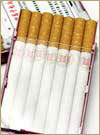
|
Cured, shredded and reprocessed tobacco is packed In a white paper tube (about 0.7 to 1.1 gram tobacco per cigarette).
Tobacco types used: Cigarette tobacco is mostly flue cured ‘Virginia’ (‘Bright’) tobacco. It is typically blended with smaller amounts of White Burley and Oriental tobacco (All three are varieties of Nicotiana tabacum). These are tobaccos mild in taste (‘American blend’). 1
Modern cigarettes generally contain additives, many of which are harmful. Some have the function of making the taste sweeter or the smoke milder on the throat, and reduce the odor and visibility of the smoke. The harmfulness of the smoke remains undiminished by these masking techniques. 2
Reductions in tar and nicotine have not had the desired effect of reducing disease appreciably. 3
|
Addiction, cancer of the lung, larynx, oral cavity, pharynx, oesophagus, stomach, pancreas, liver, kidney, urinary bladder and cervix and myeloid leukaemia 4,5
Also heart disease, clogged arteries, stroke, chronic obstructive lung disease, and adverse reproductive effects as well as periodontitis (gum disease) 4 |
Teenagers, men, young women, business persons, media persons and professionals. 6, 7 According to National Sample Survey data 8, 3.7% of rural and 9.6% of urban households consume cigarettes. 9 |
Bidis
A hand-made commercial smoking product requiring frequent puffing. Due to their
non-porous wrapper, bidis deliver more nicotine and tar to the user per unit time than cigarettes do despite containing much less tobacco: bidis typically contain 0.15-0.25 g of tobacco. 10
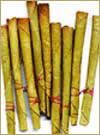
|
Flakes of sun-cured tobacco (Nicotiana tabacum) are rolled in a hand-rolled dried leaf of a tree (tendu, temburni, etc). 11, 12
Bidis contain tobaccos from different cultivars blended for flavour and to remain lit longer. 13
Bidis made for export are often flavoured with fruit or chocolate flavours. They tend to be attractive to teenagers. 14 |
Addiction, cancer of the lung, larynx, oral cavity, pharynx, oesophagus, stomach, pancreas, liver, kidney, urinary bladder and cervix and myeloid leukaemia. 4,5
Also heart disease and clogged arteries, stroke, chronic obstructive lung disease, tuberculosis15 and adverse reproductive effects 4 |
Men and a few women, mainly from middle and lower socioeconomic classes.
Very popular all over India and wherever Indians emigrate: As per NSSO data, 37% of rural and 20% of urban households consume bidis in India 9 |
Hookah – Indian waterpipe
Originated among Moghul rulers. Mostly smoked in North India. Tobacco is slowly burned over smouldering charcoal in a covered bowl and the smoke is made to pass through water before being inhaled.11
Other names for the waterpipe include hubble bubble, narghile, and sheesha
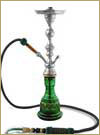
|
Hookah tobacco, stronger than cigarette or bidi tobacco, is mixed, in the proportion of 30% tobacco with 70% molasses/honey and fruit pulp. Around 20 grams of this tobacco mixture is smoked at each sitting and shared among users. The water filter is not very effective in removing tar, nicotine or carbon monoxide. 16
While hookah smoking has declined from at least
the 1950s in favour of bidis and cigarettes 17 recently hookah bars and restaurants are coming up, mainly attracting affluent young adults. Due to the fruit flavour of the smoke and the water filter, many users, who are not otherwise regular smokers, may underestimate the harm and the potential for addiction to tobacco. Hookah smoke contains much more carbon monoxide than cigarette or bidi smoke due to the use of charcoal, which may result in headaches or even death (carbon
monoxide poisoning). Depending on the number of times the person smokes the hookah during a session (e.g. 45 minutes), it is possible to inhale many times more nicotine and other harmful tobacco smoke constituents than from one cigarette, which can have immediate effects on the heart.16 |
Addiction, cancer of the lung, larynx, oral cavity, pharynx, oesophagus, stomach, pancreas, liver, kidney, urinary bladder and cervix and myeloid leukaemia 4 , 5 Also heart disease and clogged arteries, stroke, chronic obstructive lung disease and adverse reproductive effects.4 Also carbon monoxide poisoning and transmission of tuberculosis, herpes and hepatitis 16 |
Men, women, especially in rural areas of Northern and Eastern India and now Young patrons at specialized restaurants and bars in urban areas having water pipes. According to NSSO data, 2.6% of rural and 0.4% of urban households consume hookah tobacco. 9
The hookah is often shared by a group. |
Other pipes
Chilum (straight conical clay pipe) – requires deep pulmonary effort. 11
Hookli (hook -shaped clay pipe, often with a wooden stem) 11
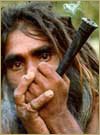
|
Pipe tobacco tends to be darker and stronger than cigarette tobaccos in general. About 15 grams of tobacco may be smoked daily. 12 |
Addiction, cancer of the lung, larynx, oral cavity, pharynx, oesophagus, stomach, pancreas, liver, kidney, urinary bladder and cervix and myeloid leukaemia, 4,5 Also heart disease, clogged arteries, stroke, chronic obstructive lung disease and adverse reproductive effects.4 |
Men, mainly in rural North India, e.g., Gujarat, Uttar Pradesh. Sometimes shared by a group.12 a practice which could spread tuberculosis. |
Chutta
Hand –made smoking product from small scale and cottage manufacture. Women typically smoke chuttas in reverse. 11
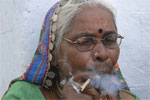
|
Coarsely prepared small cigars, made by rolling a tobacco leaf into a cylindrical shape and tying it at one end. 12
|
Addiction, cancer of the lung, larynx, oral cavity, pharynx, oesophagus, stomach, pancreas, liver, kidney, urinary bladder and cervix, myeloid leukaemia.4,5and cancer of the palate (in reverse smokers).18
Also heart disease and clogged arteries, stroke, chronic obstructive lung disease and adverse reproductive effects. 4 |
Rural men and women in Andhra Pradesh, Tamil Nadu and Orissa 11 |
Dhumti
Home-made smoking product. 11 |
A user-made conical roll of tobacco in a leaf, usually of jackfruit. Some people smoke a dhumti in reverse. 11
|
Addiction, cancer of the lung, larynx, oral cavity, pharynx, oesophagus, stomach, pancreas, liver, kidney, urinary bladder and cervix and myeloid leukaemia. 4 , 5 and cancer of the palate in reverse smokers.19 Also heart disease, clogged arteries, stroke, chronic obstructive lung disease and adverse reproductive effects. 4 |
Rural men and women almost exclusively in Goa 12 |
Cheroot
A manufactured smoking product made in Tamil Nadu.
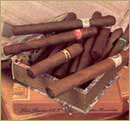
|
A cheroot is a commercially made roll of heavy bodied tobacco held together with a binder, fermented and clipped at both ends. Similar to a cigar.
|
Addiction, cancer of the lung, larynx, oral cavity, pharynx, oesophagus, stomach, pancreas, liver, kidney, urinary bladder and cervix and myeloid leukaemia. 4,5 Also heart disease, clogged arteries, stroke, chronic obstructive lung disease and adverse reproductive effects4 |
Urban and rural men and women (1.0% rural and 0.6% urban households consume cheroots in India. 9 While not commonly smoked in India, they are exported, e.g., to Europe. |
Cigar
A factory made smoking product. 11
Cigar smokers tend not to inhale the smoke.
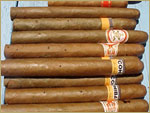
|
A cigar contains air-cured fermented tobacco filler, held together by a processed tobacco binder, covered with a tobacco-leaf spiral wrapper, and tapered ends.
|
Addiction, cancer of the lung, larynx, oral cavity, pharynx, oesophagus, stomach, pancreas, liver, kidney, urinary bladder and cervix and myeloid leukaemia. 4,5 Also heart disease, clogged arteries, stroke, chronic obstructive lung disease, and adverse reproductive effects 4 |
Affluent urban men and women. |
Electronic Nicotine Delivery Devices (ENDD), also known as Electronic Cigarettes
|
Nicotine typically dissolved in propylene glycol and glycerine, sometimes with flavourings, is held in a small cartridge. When turned on, the device heats the liquid using battery power, to create an aerosol for inhalation.
|
Long term effects are as yet unknown. |
Adolescents, young adults, others. |
Back to Top
|
| |
.: Smoking Tobacco Products
Smokless Tobacco Products
|
Ingredients |
Major Disease Consequences |
Main users |
Smokeless Tobacco
Chewed, held in the mouth or applied to gums and teeth. 11
|
With areca nut or without it
Additives:
Sugar, saccharine
Spices: clove (lavang), anise
(saunf), cardamom (elaichi),
nutmeg (jaifal).
Scents used in many of the
above smokeless products mask
the odour of tobacco and appeal
to the user. They include camphor, sandalwood, musk, rose, kewra and other attars (oil based perfumes), or musk.
Magnesium and calcium
carbonate, regulated food
additives, are ostensibly used to keep the smokeless products free flowing, however they may have other functions for the palatability or addictive-ness of the products. Other additives may also be used.
|
The International Agency for Research on Cancer has established that smokeless tobacco causes addiction, cancers of the oral cavity and oesophagus.5,20Smokeless tobacco use also causes acute increases in blood pressure and heart rate, cardiovascular disease, and adverse reproductive outcomes. Any smokeless tobacco product may also cause periodontitis (gum disease).20The International Agency for Research on Cancer has established that areca nut, often used with smokeless tobacco, causes oral cancer.5
|
All ages use these products: men women, children. Used in both urban and rural areas.
|
Plain chewing Tobacco
It goes by several names Pattiwala (Sun-dried flaked tobacco used in Uttar Pradesh), Hogesappu (leaf tobacco used in Karnataka) Kaddipudi (a powdered tobacco used in Kerala). Usually used with slaked lime.11
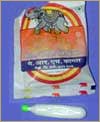
|
Tobacco. Users may mix lime (aqueous calcium hydroxide) with the tobacco before chewing it.
|
Addiction, oral cancer, cavity , oesophagus5 acute increases in blood pressure and heart rate, cardiovascular disease, and adverse reproductive outcomes 20
|
Men and women in North India. Probably the most popular form of smokeless tobacco used in India, as according to NSSO data, 19.4% and 7.4% of households in India consume leaf tobacco 9
|
Khaini
Chewed and held in the mouth
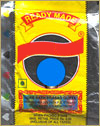
|
Sun dried tobacco and slaked lime. Commercial khaini is flavoured with cardamom, menthol and other flavourings. |
Addiction, oral cancer, cavity , oesophagus5 acute increases in blood pressure and heart rate, cardiovascular disease, and adverse reproductive outcomes 20
|
Men and women of North India, also including Bihar, Gujarat and Maharastra 11 |
Zarda
Chewed and held in the mouth. Very popular.

|
Zarda - a scented chewing tobacco product 12 spices and musk, and often containing saffron. Traditional zarda is brown in color. Contemporary commercial zarda has a white/beige powdery appearance. It has been promoted along with supari mix for simultaneous use, especially while some states had banned gutka sales. |
Addiction, oral cancer, cavity , oesophagus5 acute increases in blood pressure and heart rate, cardiovascular disease, and adverse reproductive outcomes 20
|
Men and women in North India 12 |
Kiwam
Chewed and held in the mouth.
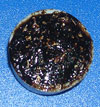
|
Tobacco paste, or granules pellets of the paste, flavoured with spices and musk. 12 |
Addiction, oral cancer, cavity , oesophagus5 acute increases in blood pressure and heart rate, cardiovascular disease, and adverse reproductive outcomes 20
|
Men and women in North India 12 |
Back to Top
Product
|
Ingredients |
Major Disease Consequences |
Main users |
Bajjar/Tapkheer
(Dry Snuff)
Applied on gums and teeth,11 especially by women in Gujarat.

|
Powdered tobacco
|
Addiction, oral cancer, cavity , oesophagus5 acute increases in blood pressure and heart rate, cardiovascular disease, and adverse reproductive outcomes 20
|
Mostly women, especially in Gujarat 12
|
Masheri
(or Mishri)
Masheri (mishri) is mainly used in Maharashtra. Users typically apply it to teeth and gums several times a day, due to nicotine addiction. 11
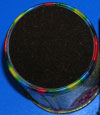
|
Masheri (misheri or mishri) - This is roasted or burnt and powdered tobacco. Users typically apply it to teeth and gums several times a day, due to nicotine addiction. (Another meaning of mishri is crystallized sugar.) Commonly used in Maharashtra.. Masheri is carcinogenic. Masheri use during pregnancy leads to low birthweight babies.
|
Addiction, oral cancer, cavity , oesophagus5 acute increases in blood pressure and heart rate, cardiovascular disease, and adverse reproductive outcomes 20
|
Women, men, children mainly used in Maharashtra 12
|
Gul
Applied for use as a dentifrice in North- Eastern India. 11
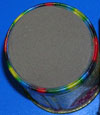
|
A pyrolised tobacco product. |
Addiction, oral cancer, cavity , oesophagus5 acute increases in blood pressure and heart rate, cardiovascular disease, and adverse reproductive outcomes 20
|
Women, men, children especially in Northern, Eastern and Northeastern India 12 |
Gudhaku
Applied to teeth and gums for cleaning teeth.11 |
Gudhaku is a paste of tobacco powder and molasses. 11 ,12 |
Addiction, oral cancer,5 and possibly other diseases, depending on the amount used 20
|
Mainly women; some men Used in Bihar and other parts of eastern India .11 ,12 |
Back to Top
Product
|
Ingredients |
Major Disease Consequences |
Main users |
Tobacco Toothpaste
Applied with a toothbrush. Users may apply it several times a day due to nicotine addiction.11

|
Creamy Snuff and Dentobac are commercial tobacco toothpaste containing scent. Tobacco in any dentifrice is banned by law 21 |
Addiction, cancer the oral cavity and oesophagus acute increases in blood pressure and heart rate, cardiovascular disease, and adverse reproductive outcomes20
|
Women, men, children has been documented as popular among children in Goa11,12
|
Tobacco water
Known as tuibur in Mizoram and hidakphu in Manipur. 5 to 10 ml tobacco water22 is held in the mouth for 5-10 minutes and then spat out. Offerred to guests. Also used for cleaning teeth 23 |
Tobacco water is made by passing tobacco smoke through water. The brownish water is collected for use and sale. |
Addiction, cancer the oral cavity and oesophagus5 acute increases in blood pressure and heart rate, cardiovascular disease, and adverse reproductive outcomes20 Tuibur may also cause stomach cancer 5,20 |
Men and women in Northeastern India 23 |
Products containing tobacco and areca nut:
Product
|
Ingredients |
Major Disease Consequences |
Main users |
Paan with tobacco
Chewed and held in the mouth paan with tobacco is used in many Asian countries.24
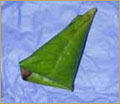
|
Betel Quid: areca nut, betel leaf, lime and catechu. Other ingredients are for flavour, like spices and condiments. Any form of smokeless tobacco is incorporated in paan 11 |
Addiction, oral submucous fibrosis, oral cancer, pharyngeal cancer, esophageal cancer5 pancreatic cancer, worsening of asthma, increased blood pressure and heart rate, heart attacks, reduced male fertility and adverse reproductive outcomes.20 And type II diabetes25,26 |
Men and women. Paan with tobacco is a very common mode of consuming smokeless tobacco in India. 11
|
Gutka
Chewed and held in the mouth.

|
A sweetened scented commercial mixture of supari, tobacco, catechu, lime, flavourings (typically menthol, saffron) and spices (typically cardamom, clove or eugenol, which is oil of cloves). 12 Gutka generally has a white/beige powdery appearance. |
Addiction, oral submucous fibrosis, oral cancer, pharyngeal cancer, oesophageal cancer5 worsening of asthma, increased blood pressure and heart rate, cardiovascular disease, adverse reproductive outcomes20 And and type II diabetes25,26 Gutka is probably the most hazardous smokeless tobacco product sold in India. |
Men, women, children.
Very popular in India and wherever Indians emigrate. Use of gutka and other commercial mixtures of tobacco and areca nut have been increasing generally in India 24and rising among school children in rural areas27 |
Mawa
Chewed and held in the mouth. |
A scented and flavoured mixture of shredded areca nuts, lime and tobacco. 11 The packaged version of this product is virtually the same a gutka and has a white/beige powdery appearance. The name may have been adopted on commercial preparations to evade bans on gutka. |
Addiction, oral submucous fibrosis and oral cancer, pharyngeal and oesophageal cancer 5 worsening of asthma, increased blood pressure and heart rate, heart attacks, adverse reproductive outcomes 20 And and type II diabetes25,26 |
Men, women, children |
Mainpuri Tobacco
Chewed and held in the mouth. |
Tobacco and slaked lime, finely cut betel nut, powdered cloves or camphor. 11 |
Addiction, oral submucous fibrosis and oral cancer, pharyngeal and oesophageal cancer 5 increased blood pressure and heart rate, heart attacks, adverse reproductive outcomes 20 And and type II diabetes25,26 |
Men, women in Uttar Pradesh 11,12 |
Back to Top
Products containing areca nut but not tobacco:
Product
|
Ingredients |
Major Disease Consequences |
Main users |
Areca nut products used orally
Note: Areca nut (also known as betel nut or supari) has addictive properties but is less addictive than tobacco.
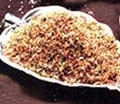
|
With or without areca nut. Some are simple mouth fresheners without areca nut.
Many have the same additives as smokeless tobacco products |
Addiction, oral submucous fibrosis, increased risk of oral cancer, oesophageal cancer 5, altered blood pressure , worsening of asthma, type II diabetes25 & coronary artery disease26 |
Men, women, children
|
Paan without tobacco
Chewed all over India

|
Betel Quid: areca nut, betel leaf, lime and catechu. Other ingredients are for flavour, like spices and condiments.
|
Addiction, oral submucous fibrosis, increased risk of oral cancer, oesophageal cancer 5, altered blood pressure , worsening of asthma, type II diabetes25 & coronary artery disease26 |
Men and women all over India, especially those who use pan occasionally 11,12 |
Pan Masala
Chewed and held in the mouth
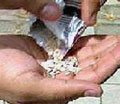
|
A sweetened, sometimes scented, commercial mixture of areca nut (supari), flavourings (e.g., menthol and saffron), and spices. Pan masala has a white/beige powdery appearance. Generally, nowadays, pan masala is understood as a non- tobacco product, but in the past, some brands of pan masala contained tobacco. |
Addiction, oral submucous fibrosis, increased risk of oral cancer, oesophageal cancer 5, altered blood pressure , worsening of asthma, type II diabetes25 & coronary artery disease26 |
Children, women,men |
Supari
Typically chewed as a digestive after meals or for any time for freshening the breath or as a mild stimulant.(Reddy,Gupta 2003)11 Supari is also an ingredient of pan masala and gutka as well as some mouth fresheners (mukhwas).
From the association of supari with betel leaves (of the creeper Piper betle), the term ‘betelnut’ was coined for supari. Tukda and Chalia are other names for supari in parts of South Asia. Tamol is a fermented form of areca nut chewed in Assam. 11
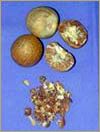
|
a. Supari is Areca nut, the seed of the Areca palm, broken into pieces and chewed by itself, or with betel leaves, lime (aqueous Calcium hydroxide) and catechu, as paan. Paan is technically known as betel quid.
b. Supari also denotes a commercially prepared sweetened mixture (sugar and saccharine) of pieces of processed areca nut (usually reddish brown), spices (e.g. saunf) and flavourings (e.g menthol). Such a mixture may be labelled as scented supari, a mouth freshener or an "after mint". |
Addiction, oral submucous fibrosis, oral cancer, oesophageal cancer5, altered blood pressure, worsening of asthma & incresed the risk of type II diebetes. 25,26
|
Men, women, children |
References
-
-
Connolly GN, Wayne GD, Lymperis D, Doherty MC. How cigarette additives are used to mask environmental tobacco smoke.Tob Control. 2000;9:283-291.
- Hoffmann, D., Hoffman, I., and El-Bayoumy, K. (2001). The less harmful cigarette: A controversial issue. A Tribute to Ernst L. Wynder. Chemical Research in Toxicology, 14:767-790. Available from: https://pubs.acs.org/doi/abs/10.1021/tx000260u
- US Department of Health and Human Services. The health consequences of smoking: A report of the Surgeon General. Atlanta: US Department of Health and Human Services, Centers for Disease Control and Prevention, National Center for Chronic Disease Prevention and Health Promotion, Office of Smoking and Health; 2004. p. 42-83,116-119, 126 , 167-170 , 324;
Available from: https://www.ncbi.nlm.nih.gov/books/NBK44695/
.
- International Agency for Research on Cancer (IARC) Monographs on the Evaluation of the Carcinogenic Risk of Chemicals to Humans. Volume 100E. Personal Habits and Indoor Combustions. Lyon: International Agency for Research on Cancer; 2012. p. 43-212, 265-317, 333-372; Available from: http://monographs.iarc.fr/ENG/Monographs/vol100E/index.php
- Narayan VKM, Chadha SL, Hanson RL, Tandon R, Shekhawat S, Fernandes RJ, et al. Prevalence and patterns of smoking in Delhi: cross sectional study. BMJ. 1996; 312:1576-1579.
- Sorensen G, Gupta PC, Pednekar MS. Social Disparities in Tobacco Use in Mumbai, India: The Roles of Occupation, Education and Gender. American Journal of Public Health, June 2005; 95 (6): 1003-1008.
- NSSO, Socio-Economic Survey, 55th Round: July 1999 - June 2000, Household Schedule 1.0: Consumer Expenditure, National Sample Survey Organization, Government of India, New Delhi, 2000.
- John RM. Household's Tobacco Consumption Decisions: Evidence from India. Journal of South Asian Development. 2006;1(1):119-147.
-
Richter P, Watson C. Chemistry and Toxicology. In: Gupta PC, Asma S (eds.) Bidi Smoking and Public Health, New Delhi: Ministry of Health and Family Welfare, Government of India, 2008. p 61-100. Available from:
.
http://www.who.int/tobacco/publications/prod_regulation/bidi_smoking_public_health.pdf
- Reddy KS and Gupta PC (eds). Report on Tobacco Control in India. Ministry of Health and Family Welfare, Government of India, New Delhi, 2004. (a) Historical records and anecdotes: from the middle ages to modern times. p 7-18; p 43-48. Available online from:http://www.who.int/fctc/reporting/Annex6_Report_on_Tobacco_Control_in_India_2004.pdf
- Bhonsle RB, Murti PR and Gupta PC. Tobacco Habits in India. In: Gupta PC, Hamner JE III, Murti PR, eds. Control of Tobacco-related Cancers and Other Diseases. Proceedings of an International Symposium, TIFR, Bombay, January 15-19, 1990. Oxford University Press, Bombay, 1992, pp 25-46.
- John S. History and culture of bidis in India. In: Gupta PC, Asma S (eds.) Bidi Smoking and Public Health, New Delhi: Ministry of Health and Family Welfare, Government of India, 2008. p. 1-12. Available from:
http://www.who.int/tobacco/publications/prod_regulation/bidi_smoking_public_health.pdf
- O’Hegarty M, Nichter M. Marketing, Promotion and Availability of Bidis in the United States.In: Gupta PC, Asma S (eds.) Bidi Smoking and Public Health, New Delhi: Ministry of Health and Family Welfare, Government of India, 2008. p. 13-25.
Available from:
http://www.who.int/tobacco/publications/prod_regulation/bidi_smoking_public_health.pdf
- Disease Consequences In: Gupta PC, Asma S (eds.) Bidi Smoking and Public Health, New Delhi: Ministry of Health and Family Welfare, Government of India, 2008. Chapter 4, Disease consequences: p 113-165. Available from: http://www.who.int/tobacco/publications/prod_regulation/bidi_smoking_public_health.pdf
- Ray CS. The hookah – the Indian waterpipe. Current Science. 2009;96(10):1319-1323. Available from: http://www.currentscience.ac.in/cs/Downloads/article_id_096_10_1319_1323_0.pdf
- Sanghvi LD. Challenges in tobacco control in India. In: Gupta PC, Hamner JE III, Murti PR, eds. Control of Tobacco-related Cancers and Other Diseases. Proceedings of an International Symposium, TIFR, Bombay, January 15-19, 1990. Oxford University Press, Bombay, 1992, pp 47-56.
- van der Eb MM, Leyten EM, Gavarasana S, Vandenbroucke JP, Kahn PM, Cleton FJ. Reverse smoking as a risk factor for palatal cancer: a cross-sectional survey in rural Andhra Pradesh, India. Int J Cancer 1993 Jul 9;54(5):754-8.
- Bhonsle RB, Murti PR, Gupta PC, Mehta FS. Reverse dhumti smoking in Goa: An epidemiologicstudy of 5,449 villagers for oral precancerouslesions. Indian Journal of Cancer 1976; 13: 301-305.
- IARC Monographs on the Evaluation of the Carcinogenic Risk of Chemicals to Humans. Vol. 89. Smokeless Tobacco and Some Tobacco-specific N-Nitrosamines. Lyon: International Agency for Research on Cancer; 2007. Available from: http://monographs.iarc.fr/ENG/Monographs/vol89/index.php
- Simpson D. India: tobacco toothpaste squeezed out. Tobacco Control 1997;6: 171-4.
- Phukan RK, Zomawia E, Narain K, Hazarika NC, Mahanta J. Tobacco use and stomach cancer in Mizoram, India. Cancer Epidemiol Biomarkers Prev. 2005 Aug;14(8):1892-6. Available from: http://cebp.aacrjournals.org/content/14/8/1892.full
- Sinha DN, Gupta PC, Pednekar M. Tobacco water: A special form of tobacco use in the Mizoram and Manipur states of India. Natl Med J India 2004 Sep/Oct;17(5):245–7. Available from: http://archive.nmji.in/archives/volume_17_5_September_october/Short_reports/Tobacco_water.pdf
- Gupta PC, Warnakulasuriya S. Global epidemiology of areca nut usage. Addiction Biology 2002;7 (1), 77–83.
- IARC Monographs on the Evaluation of the Carcinogenic Risk of Chemicals to Humans. Vol. 85. Betel-quid and Areca-nut Chewing and Some Areca-nut-derived Nitrosamines. Lyon: International Agency for Research on Cancer; 2004. Available from: http://monographs.iarc.fr/ENG/Monographs/vol85/index.php
- Garg A, Chaturvedi P, Gupta PC. A review of the systemic adverse effects of areca nut or betel nut. J Med Paediatr Oncol 2014;35(1):3-9. Available from: https://www.ncbi.nlm.nih.gov/pmc/articles/PMC4080659/
- Chaturvedi P, Chaturvedi U. Prevalence of tobacco consumption in school children in rural India: an epidemic of tobaccogenic cancers looming ahead in the third world. J Cancer Educ 2002; 17: 6.
|
|
__________________________________________________________________________________________________________________________
`````````````````````````````````````````````````````````````````````````````````````````````````````````````````````````` |
|
